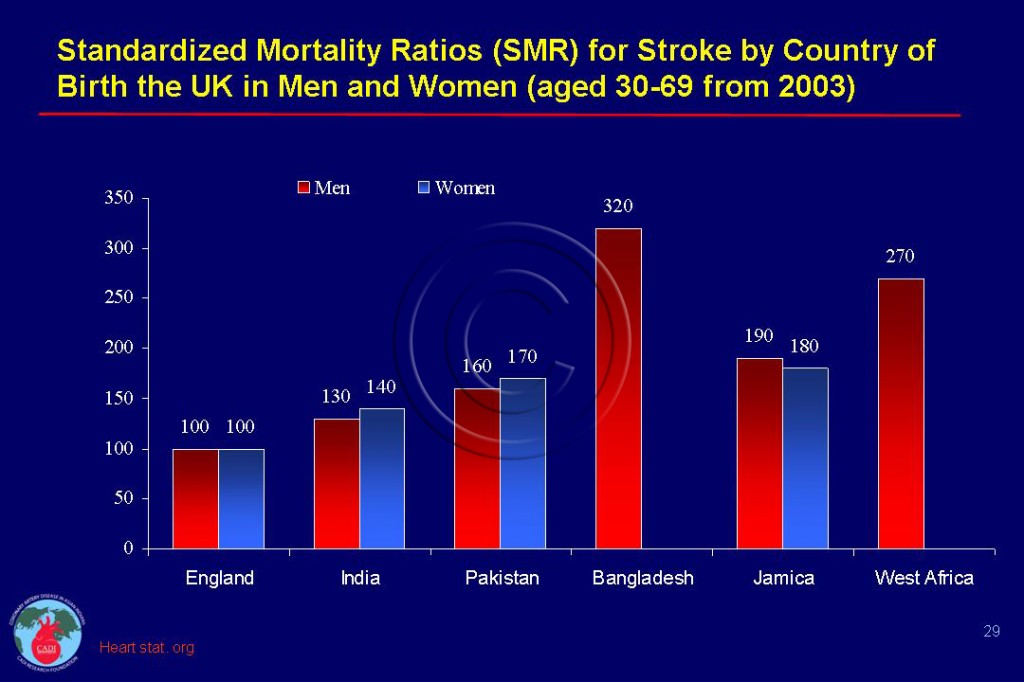Cardiovascular Disease in Women
- Cardiovascular diseases (CVD) cause 8.6 million deaths among women annually. CVD is the largest single cause of mortality among women, accounting for a third of all women’s deaths worldwide. CVD kills more women than all cancers, tuberculosis, HIV/AIDS and malaria combined.1
- Every year, more women than men die of CVD.1 81% of all CVD deaths among women occur in low- and middle-income countries where it results in more deaths than those from pregnancy-related causes.
- Women with CVD fare worse than men, experiencing a higher proportion of CVD deaths than men.1 This is particularly true of women in low- and middle income countries where those who develop CVD are more likely to die from it than comparable women in industrialized nations.1
- Women are more likely than men to experience serious problems become disabled by stroke.2
- In the US, stroke accounts for a higher proportion of CVD events than coronary artery disease (CAD) in females, whereas the ratio is the opposite in males. Each year 55,000 more women die of stroke than men, and before 75 years of age.1
- The stroke mortality is higher among South Asian women than white and black women ( Figure 029).3
- Women are less likely to have important tests and interventions after a stroke, compared to men, even though life-saving emergency treatments appear more effective in women than men.2, 4 Women receive less aggressive treatment for CVD than men and this is due, at least in part, to the under diagnosis in women.5-7
- Estimates suggest that 70% of CVD deaths are attributed to modifiable risk factors (See Risk Factors).1
- Atrial fibrillation is independently associated with a 4 to 5-fold increased risk of ischemic stroke and is responsible for 15% to 20% of all ischemic strokes.1
- An obese woman has a 45% higher risk of dying from CVD, compared with normal weight women.8
- Educating women greatly increases their willingness and ability to take heart-protective action.9
- Women’s awareness of their risk of heart disease and stroke is increasing but women often underestimate their personal risk.1Studies show women do not perceive CVD as the greatest threat to their health.10 Young women still feel more threatened by cancer than they do by CVD.9
Sources
1. Mosca L, Benjamin EJ, Berra K, et al. Effectiveness-based guidelines for the prevention of cardiovascular disease in women-2011 update a guideline from the american heart association. J Am Coll Cardiol. Mar 22 2011;57(12):1404-1423.
2. Di Carlo A, Lamassa M, Baldereschi M, et al. Sex differences in the clinical presentation, resource use, and 3-month outcome of acute stroke in Europe: data from a multicenter multinational hospital-based registry. Stroke. May 2003;34(5):1114-1119.
3. www.heartstats.org. CHD Statistics. Mortality. 2011. Accessed July 15, 2011.
4. Shah SH, Liebeskind DS, Saver JL, et al. Influence of gender on outcomes after intra-arterial thrombolysis for acute ischemic stroke. Neurology. Jun 13 2006;66(11):1745-1746.
5. Doyle F, De La Harpe D, McGee H, Shelley E, Conroy R. Gender differences in the presentation and management of acute coronary syndromes: a national sample of 1365 admissions. Eur J Cardiovasc Prev Rehabil. Aug 2005;12(4):376-379.
6. Blomkalns A L, Chen AY, Hochman JS, et al. Gender disparities in the diagnosis and treatment of non-ST-segment elevation acute coronary syndromes: large-scale observations from the CRUSADE (Can Rapid Risk Stratification of Unstable Angina Patients Suppress Adverse Outcomes With Early Implementation of the American College of Cardiology/American Heart Association Guidelines) National Quality Improvement Initiative. J Am Coll Cardiol. Mar 15 2005;45(6):832-837.
7. Weisz D, Gusmano MK, Rodwin VG. Gender and the treatment of heart disease in older persons in the United States, France, and England: a comparative, population-based view of a clinical phenomenon. Gend Med. Aug 2004;1(1):29-40.
8. Murphy N. F., MacIntyre K, Stewart S, Hart CL, Hole D, McMurray JJ. Long-term cardiovascular consequences of obesity: 20-year follow-up of more than 15 000 middle-aged men and women (the Renfrew-Paisley study). Eur Heart J. Jan 2006;27(1):96-106.
9. Mosca L, Mochari H, Christian A, et al. National study of women’s awareness, preventive action, and barriers to cardiovascular health. Circulation. Jan 31 2006;113(4):525-534.
10. American Heart Association. Heart and Stroke Statistical Update2011.


